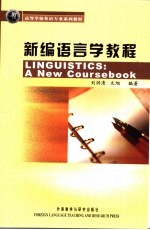图书介绍
新编语言学教程PDF|Epub|txt|kindle电子书版本网盘下载

- 刘润清,文旭编著 著
- 出版社: 北京:外语教学与研究出版社
- ISBN:756005398X
- 出版时间:2006
- 标注页数:358页
- 文件大小:14MB
- 文件页数:374页
- 主题词:语言学-高等学校-教材-英文
PDF下载
下载说明
新编语言学教程PDF格式电子书版下载
下载的文件为RAR压缩包。需要使用解压软件进行解压得到PDF格式图书。建议使用BT下载工具Free Download Manager进行下载,简称FDM(免费,没有广告,支持多平台)。本站资源全部打包为BT种子。所以需要使用专业的BT下载软件进行下载。如BitComet qBittorrent uTorrent等BT下载工具。迅雷目前由于本站不是热门资源。不推荐使用!后期资源热门了。安装了迅雷也可以迅雷进行下载!
(文件页数 要大于 标注页数,上中下等多册电子书除外)
注意:本站所有压缩包均有解压码: 点击下载压缩包解压工具
图书目录
Chapter 1 Introduction1
1.1 Linguistics1
1.1.1 Definition of linguistics1
Contents1
1.1.2 Linguistics versus traditional grammar2
1.1.3 Use of studying linguistics3
1.1.4 Scope of linguistics4
1.2 Language8
1.2.1 Definition of language8
1.2.2 Origin of language9
1.2.3 Design features of language10
1.2.4 Functions of language13
1.3 Some Major Concepts in Linguistics15
1.3.1 Descriiptive and prescriptive grammars15
1.3.2 Synchronic and diachronic linguistics15
1.3.4 Competence and performance16
1.3.3 Langue and parole16
1.3.5 Syntagmatic and paradigmatic relations17
1.3.6 Functionalism and formalism18
Exercises and Discussion Questions18
Sources and Suggestions for Further Reading19
Supplementary Readings20
Chapter 2 The Sounds of Language25
2.1 Introduction25
2.2 Phonetics25
2.2.1 Articulators and their functions26
2.2.2 Voiced and voiceless sounds29
2.2.3 Nasal and oral sounds30
2.2.4 Classification of English speech sounds31
2.2.4.1 English consonants32
2.2.4.2 English vowels34
2.2.5.2 Elision and assimilation35
2.2.5 Variations of sounds35
2.2.5.1 Liaison35
2.3 Phonology36
2.3.1 Phonemes:the phonological units of language37
2.3.2 Minimal pairs and sets38
2.3.3 Free variation39
2.3.4 Distinctive features39
2.3.5 Syllables and consonant clusters40
2.3.6 Suprasemental features43
2.3.6.1 Stress43
2.3.6.2 Intonation44
Exercises and Discussion Questions45
Sources and Suggestions for Further Reading46
Supplementary Readings47
3.1 Introduction52
3.2 Morphemes52
Chapter 3 Morphology52
3.2.1 Free morphemes53
3.2.2 Bound morphemes53
3.3 Morphs and Allomorphs56
3.4 Types of Word Formation57
3.4.1 Compounding57
3.4.2 Derivation58
3.4.3 Other ways of word formation60
3.4.3.1 Conversion60
3.4.3.2 Backformation60
3.4.3.3 Clipping61
3.4.3.4 Blending61
3.4.3.5 Acronym61
3.4.3.6 Initialism62
Exercises and Discussion Questions63
Supplementary Readings65
Sources and Suggestions for Further Reading65
Chapter 4 Syntax70
4.1 Introduction70
4.2 Word classes71
4.3 The Prescriptive Approach73
4.4 The Descriptive Approach74
4.4.1 Structural analysis74
4.4.2 Immediate constituent analysis75
4.5 Constituent Structure Grammar77
4.6 Transformational Grammar83
4.7 Systemic Functional Grammar87
Exercises and Discussion Questions95
Sources and Suggestions for Further Reading96
Supplementary Readings97
5.1 Definition of Semantics103
Chapter 5 Semantics103
5.2 Approaches to Meaning104
5.2.1 Meaning as naming105
5.2.2 Meaning as concept106
5.2.3 Meaning as behavior107
5.2.4 Meaning as context107
5.2.5 Meaning as truth conditions109
5.3 Word Meaning110
5.3.1 Sense and reference110
5.3.2 Seven types of meaning111
5.3.2.1 Conceptual meaning111
5.3.2.2 Connotative meaning112
5.3.2.3 Social meaning113
5.3.2.4 Affective meaning114
5.3.2.5 Reflective meaning115
5.3.2.6 Collocative meaning115
5.3.2.7 Thematic meaning116
5.3.3 Semantic fields117
5.3.4 Componential analysis118
5.3.5 Semantic relationships between words120
5.3.5.1 Homonymy121
5.3.5.2 Polysemy121
5.3.5.3 Homophony122
5.3.5.4 Synonymy122
5.3.5.5 Antonymy123
5.3.5.6 Hyponymy124
5.3.5.7 Meronymy125
5.4 Sentence Meaning126
5.4.1 Sentence and proposition126
5.4.2 Semantic roles127
5.4.3.1 Entailment131
5.4.3.2 Presupposition131
5.4.3 Semantic relationships between sentences131
5.4.3.3 Synonymy132
5.4.3.4 Inconsistency132
5.4.3.5 Implicature132
Exercises and Discussion Questions133
Sources and Suggestions for Further Reading135
Supplementary Readings136
Chapter 6 Pragmatics141
6.1 Introduction141
6.2 Micropragmatics143
6.2.1 Reference143
6.2.2 Deixis144
6.2.3 Anaphora145
6.2.4 Presupposition146
6.3 Macropragmatics147
6.3.1.1 Illocutionary acts148
6.3.1 Speech act theory148
6.3.1.2 Classification of illocutionary acts150
6.3.1.3 Indirect speech acts151
6.3.2 The Cooperative Principle153
6.3.2.1 The Cooperative Principle and its maxims153
6.3.2.2 Conversational implicatures154
6.3.3 The Politeness Principle157
Exercises and Discussion Questions161
Sources and Suggestions for Further Reading162
Supplementary Readings163
Chapter 7 Discourse Analysis167
7.1 Discourse and Discourse Analysis167
7.2 Information Structure169
7.2.1 Given and new information169
7.2.2 Topic and comment170
7.2.3 Contrast172
7.3 Cohesion and Coherence173
7.3.1 Cohesion175
7.3.1.1 Reference175
7.3.1.2 Substitution176
7.3.1.3 Ellipsis176
7.3.1.4 Conjunction177
7.3.1.5 Lexical cohesion177
7.3.2 Coherence178
7.4 Discourse Markers180
7.5 Conversational Analysis182
7.5.1 Adjacency pairs183
7.5.2 Preference structure184
7.5.3 Presequences186
7.6 Critical Discourse Analysis187
Exercises and Discussion Questions189
Supplementary Readings190
Sources and Suggestions for Further Reading190
Chapter 8 Sociolinguistics196
8.1 Introduction196
8.2 Language Varieties197
8.2.1 Standard language197
8.2.2 Dialects198
8.2.3 Registers200
8.2.4 Pidgins and creoles202
8.2.5 Language planning203
8.3 Choosing a Code204
8.3.1 Diglossia204
8.3.2 Bilingualism and multilingualism205
8.3.3 Code-switching206
8.4 Linguistic Taboos and Euphemisms207
8.5 Language and Gender210
Exercises and Discussion Questions212
Sources and Suggestions for Further Reading213
Supplementary Readings214
Chapter 9 Psycholinguistics220
9.1 Introduction220
9.2 Language Acquisition221
9.3 Language Production223
9.3.1 Conceptualization224
9.3.2 Formulation224
9.3.3 Articulation226
9.3.4 Self-regulation226
9.4 Language Comprehension227
9.4.1 Sound comprehension228
9.4.2 Word comprehension228
9.4.3 Sentence comprehension230
9.4.4 Text comprehension231
9.5 Language and Thought232
9.5.1 Language determines thought233
9.5.2 Thought determines language235
Exercises and Discussion Questions237
Sources and Suggestions for Further Reading238
Supplementary Readings239
Chapter 10 Cognitive Linguistics243
10.1 Introduction243
10.2 Categorization and Categories244
10.2.1 The classical theory244
10.2.2 Prototype theory246
10.2.3 Levels of categorization248
10.3 Conceptual Metaphor and Metonymy249
10.3.1 Conceptual metaphor249
10.3.2 Conceptual metonymy250
10.4.1 Iconicity of order254
10.4 Iconicity254
10.4.2 Iconicity of distance255
10.4.3 Iconicity of complexity256
10.5 Grammaticalization257
Exercises and Discussion Questions259
Sources and Suggestions for Further Reading260
Supplementary Readings261
Chapter 11 Language Acquisition267
11.1 First Language Acquisition267
11.1.1 The behaviorist approach268
11.1.2 The innateness approach269
11.1.3 Stages of acquiring the first language270
11.2 Second Language Acquisition273
11.2.1 Contrastive analysis274
11.2.2 Error analysis274
11.2.3 Interlanguage276
11.3 Individual Differences in Second Language Acquisition277
11.3.1 Language aptitude277
11.3.2 Cognitive style:field dependence and field independence278
11.3.3 Personality traits280
11.3.4 Learning strategies281
11.4 Instruction and L2 Acquisition284
11.4.1 Form-focused instruction284
11.4.2 Learner-instruction matching285
11.4.3 Strategy training286
Exercises and Discussion Questions287
Sources and Suggestions for Further Reading288
Supplementary Readings289
Chapter 12 Applied Linguistics296
12.1 Introduction296
12.2 Language Teaching297
12.2.1 The grammar-translation method298
12.2.2 The direct method299
12.2.3 The audiolingual method300
12.2.4 Situational language teaching302
12.2.5 Functional language teaching303
12.2.6 Communicative language teaching305
12.2.7 Other approaches308
12.3 Testing308
12.3.1 The main types of language tests308
12.3.2 Principles of language testing313
12.4 Summary318
Exercises and Discussion Questions319
Sources and Suggestions for Further Reading319
Supplementary Readings321
Glossary326
Index341